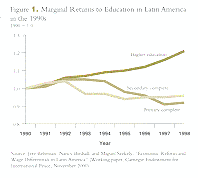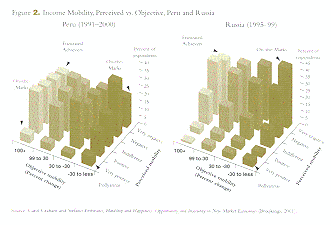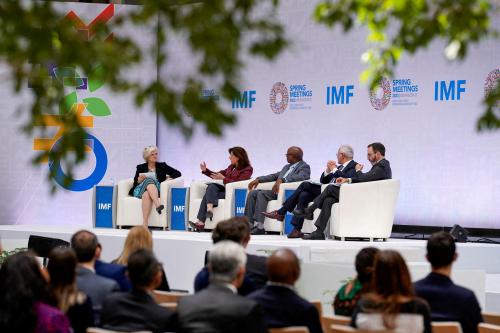In the past few years, routine meetings on the operations of the international financial institutions or on the future of free trade have filled the streets of usually peaceful cities like Seattle, Prague, and Quebec with riot police, tear gas, and protesters lashing out at globalization. The protests raise immediate and pressing logistical questions for local officials, but they also pose a more fundamental question: do the protesters represent wider popular sentiment against globalization and market policies in the world’s developing countries? Are they a sign that globalization is facing a backlash in the developing world?
The protesters claim that globalization is bad for poor people in poor countries. A large body of evidence, however, suggests the opposite—though clearly globalization can result in unsettling experiences for many who live in the developing world. My recent research with Nancy Birdsall and Stefano Pettinato suggests that globalization has brought substantial benefits and opportunities for upward mobility for many low-income individuals in the emerging economies. Yet these same opportunities entail new vulnerabilities and new risks for others.
Ironically, while the protesters focus on the plight of the poor, the groups most dissatisfied with globalization in the developing countries themselves tend to be closer to the middle of the income distribution than to the bottom. Their dissatisfaction does not portend a looming and inevitable backlash against globalization, but it does suggest that policymakers in these countries should pay attention to the insecurities of the middle class as well as those of the poor.
A genuine backlash against globalization would not take the form of demonstrations on the streets of D.C. or Seattle. Rather, it would materialize in ballot boxes in countries like Poland or Peru. In Latin America, which has led the world in implementing market reforms, many countries that once seemed modelperformers are now facing economic and political uncertainty. Argentines, for example, who were recently threatened with possible spillover effects from the economic crisis in Turkey, are facing increasing questions about the sustainability of their own currency regime, which has been central to their macroeconomic stability for more than a decade. Will voters in Latin America turn against markets and integration with the world economy?
The answer is “probably not.” In Latin America, despite widespread debate over making the market model more equitable and efficient, only one political candidate, Hugo Chavez, has so far been elected to office promising to reverse integration into global markets—and that was in Venezuela, where reform was still incomplete. But matters are far from settled. In elections last June in Peru, one of the countries that has gone furthest in implementing market reforms, Alejandro Toledo ran on a pro-market platform and barely defeated former president Alan Garcia, who gained notoriety in the late 1980s by rejecting market principles—Toledo’s margin of victory was less than 5 percent.
Who Wins and Who Loses?
Market reforms—in particular, establishing macroeconomic and fiscal stability and liberalizing trade regimes—are a prerequisite for integrating developing nations into the global economy. In Latin America, the turn to the market has delivered large—and tangible—benefits for a region plagued with high inflation, economic instability, and daunting external debt. Countries that have embraced reform have gained control of inflation, reestablished stable (if not high) growth, and liberalized and expanded the diversity of trading regimes. Most have also privatized loss—making public enterprises and insolvent social security systems.
Although market reforms are often viewed as being harsh on the poor, in reality the effect can be quite positive. Because the poor are least able to protect themselves from high inflation, for example, its elimination is particularly beneficial for them. And in many countries, market reforms have also reoriented public spending to the poor.Before reform, social spending went disproportionately to social security systems that covered limited and relatively privileged parts of the labor force, while basic social services, such as primary health and education, were severely underfunded.
Market reforms can also remove economic distortions that block the productive potential of the poor. Removing such distortions as rationed credit (because of negative real interest rates) and rigid and overprotective labor regulations that discourage hiring have helped the poor in many developing countries, as evidence from Chile, Mexico, and Peru suggests.
The same reforms that have enabled many of the poor to move well up the income distribution ladder, however, have made people somewhat higher up that ladder newly vulnerable. Many who once enjoyed middle-class status and held secure public-sector jobs have fallen into or near poverty. Relative mobility trends in reforming countries can be surprisingly volatile. Over a 10-year period many more people in Peru will move up—and down—several income quintiles than will people in the United States.
If market reforms have had different effects on people in different parts of the income distribution, what effect have they had on inequality? As our own research, building on the work of several other scholars, has shown, inequality can increase even in countries where average incomes have risen and poverty has fallen. And, indeed, aggregate measures report a mixed effect, with inequality going down in some emerging market countries and increasing slightly in others.
One trend driving the increase in inequality has been a recent upsurge in the rewards to skilled labor. Although economists had predicted that open trade would reward unskilled labor, which is in ample supply in Latin America, the greatest rewards have gone to skilled labor, which is scarce.
 As figure 1 shows, during the past decade returns to higher education in Latin America have risen far faster than returns to secondary and primary education. During the 1960s and 1970s a high school education in Latin America virtually assured a stable job, often in the public sector, as well as a middle-class—indeed, fairly privileged—standard of living. By the 1990s, however, a high school degree was much less valuable. Many public-sector jobs had disappeared, and the ones that remained were less desirable.
As figure 1 shows, during the past decade returns to higher education in Latin America have risen far faster than returns to secondary and primary education. During the 1960s and 1970s a high school education in Latin America virtually assured a stable job, often in the public sector, as well as a middle-class—indeed, fairly privileged—standard of living. By the 1990s, however, a high school degree was much less valuable. Many public-sector jobs had disappeared, and the ones that remained were less desirable.
A related trend is top-driven inequality: vast wealth among those at the top of the income ladder relative to the rest of society, where income distribution is more equal. According to an Inter-American Development Bank study by Miguel Szekely and Marianne Hilgert, the wealthiest 10 percent of individuals in many Latin American countries earn roughly 3 times what those in the next decile earn, compared with a roughly 1.5 to 1 ratio in the United States.
One cause of top-driven inequality is the rising wage premium to educated workers. Another may be a possible increase in wealth at the top, as more open capital markets enhance opportunities for high returns. In addition, taxes on mobile capital are probably declining, while in developing countries, shallow financial sectors and underdeveloped capital markets may be limiting investment opportunities for small savers and borrowers.
The uneven benefits of globalization and market reforms no doubt explain why public opinion in the developing nations is so mixed. Those who see themselves as losers are not necessarily the poor, but rather newly vulnerable members of the middle class who perceive that gains from market reforms have gone disproportionately to the top of the income distribution.
Frustrated Achievers
Most research on subjective well-being finds that once people have reached a certain income level, their sense of well-being is determined by relative rather than absolute income. Except for the very poorest countries, these findings hold across countries, regions, and development levels. My own survey research, conducted jointly with Stefano Pettinato, generally supports these findings.
In repeated household surveys in Peru during 1991—2000, a surprisingly large share (44 percent) of respondents with the most upward income mobility reported that they were worse off. Household surveys in Russia during 1995—99 got even more negative results, with 71 percent of upwardly mobile respondents reporting that they were worse off (see figure 2).
What explains these negative perceptions? In Peru, the frustrated achievers had average income, but were more urban and older than nonfrustrated upwardly mobile respondents. In Russia, they had slightly lower than average income—and also more income volatility—than their counterparts who were more content. For the most part, they were not the poorest in the sample, but rather tended toward the middle of the distribution. In Peru, while poorer respondents were much more likely to answer that their economic condition was unchanged, those in the middle were much more likely to say that it was worse.
The implications for public support for globalization are clear. In a regionwide public opinion survey of Latin America, respondents who were more satisfied with their lives were, on average, more likely to favor the market and to be satisfied with democracy. The surveys in Russia yielded similar findings. In both Russia and Peru, the frustrated achievers were less satisfied with their jobs and more critical about their economic situation vis-à-vis others in their country. These frustrations, which may influence future economic and political behavior in the emerging economies, must be addressed.
Opportunity and Insecurity
Policymakers in emerging market countries could use three strategies to reduce insecurity and enhance upward mobility—not only among the middle class, but alsoamong the poor. The first would be to make social services more widely available. Education policies, especially, could give a broader section of society access to jobs in the high-skill economic sectors. The second strategy would be to remove distortions in markets and in government policies that block the productive potential of low-income groups. Among these distortions I include excessive inequality. And the third would be to make safety nets and other forms of unemployment insurance more broadly available.
The first and most obvious way to enhance the mobility and opportunity of both the poor and the middle class is to improve access to good quality postsecondary education, including vocational education. Such a policy shift, however, will take time to bear fruit. It will also take sustained political commitment, institutional development, and substantial resources.
Fundamental to making better education more widely available is a more comprehensive social contract for delivering essential social services in general. The world’s advanced economies have vigorously debated the merits of targeted versus more universal social welfare policies (with supporters of universal policies arguing that tightly targeted policies cannot sustain the political support needed to preserve public funding). Meanwhile, many developing countries that have turned to the market have increased targeting of public social spending and reduced absolute poverty, even during times of fiscal austerity. At the same time, shifts in the rewards to different education and skill cohorts, coupled with cuts in the size and scope of public services, have led to a perception and often a reality of increased insecurity for groups in the middle of the income distribution. It is time to revisit the targeting debate. At least some targeting is usually desirable when public resources are limited. Nevertheless, it is necessary to craft a broader and more politically sustainable social contract, which includes middle-income groups as well as the poor.
Policymakers should aim to increase not only the supply of quality education, but also the demand for it. A wide body of literature, including work by economists Steven Durlauf and George Akerlof, has shown how inequality patterns can be perpetuated by persistent social norms and low expectations. In societies where the poor have no tradition of reaching higher-level education, policymakers should encourage low-income people to invest in their children’s future.
The second policy strategy is to address distortions in markets and failures in government policies. Many countries in the developing world, particularly in Latin America, have greatly improved their macroeconomic frameworks and reduced such distortions. Yet removing distortions alone is not enough. Merely replacing poorly performing public monopolies with private ones, as some countries have done, is unlikely to diminish inequality or to provide new opportunities for the poor or near poor. Adequate regulatory policies, which level the economic playing field for participants of all income levels, are essential, as are supply-side policies that facilitate the participation of the poorest citizens.
The same policy package should address inequality. Economists have shown that excessive concentration of income and assets impedes economic growth. And my recent research suggests that high inequality has additional costs in that it creates frustrations in even the most upwardly mobile individuals. These frustrations, in turn, may erode political support for market-enhancing policies that deliver sustained growth and also cut poverty.
A third essential strategy is to provide adequate safety nets. The lack of reliable safety nets can itself result in market distortions, encouraging workers to minimize risk and guarantee job security through whatever mechanisms are available, even extremely inefficient ones such as overly rigid labor laws. And the insecurity resulting from inadequate safety nets in the face of economic volatility and changing rewards to labor sectors is surely one cause of the frustrations of our achievers.
Two kinds of safety nets are necessary. One is social insurance, such as unemployment insurance, which encourages workers to try to get ahead by protecting them from the risk of income loss caused by macroeconomic volatility and other economic shocks. The second type of safety net protects the poorest who fall behind because of low skills or because poor health and other circumstances keep them from participating even in the low-skilled sector of the economy. This issue has received attention, but usually in the context of fiscal adjustments. Policymakers must develop more permanent institutions that can expand and contract as needed and provide a buffer at times of cyclical fluctuations and during downturns caused by externally driven shocks. They must also do more to manage macroeconomic volatility.
Averting Backlash
Globalization and the turn to the market have clear benefits for developing countries, both in terms of aggregate growth and poverty reduction and in terms of mobility and opportunity for low-income people. Yet new opportunities have come hand-in-hand with new vulnerabilities. Not surprisingly, public opinion about globalization and market reforms is mixed. While the street protests in the industrialized countries focus on the poor, in the developing countries people in the middle strata seem as vulnerable if not more so and also more negative in assessing their progress with the turn to the market.
That those negative perceptions exist does not mean that a backlash against globalization is inevitable. At this juncture most publics seem to be aware that self-imposed isolation from the rest of the world has high costs. Yet policymakers must address the causes of these negative perceptions—precisely so that they do not become the source of a backlash.
Reducing insecurity and distributing the benefits of reform more equitably could go a long way toward building broader and more sustainable support for continuing ,arket policies. And persuading poor people in poor countries that opportunities exist will make them much likely to invest in their children’s education—and therefore in their future in an integrated glorabl economy.



Commentary
Winners and Losers: Perspectives on Globalization from the Emerging Market Economies
September 1, 2001